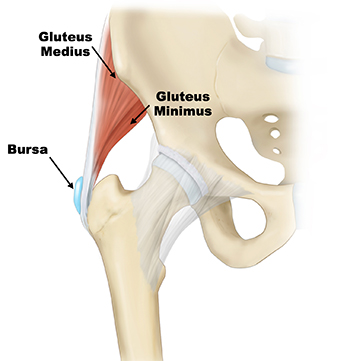Trochanteric Bursitis
What is trochanteric bursitis?
Trochanteric bursitis is a medical condition characterized by inflammation of the trochanteric bursa, which is a small, fluid-filled sac located around a part of the hip joint known as the greater trochanter. This bursa serves as a cushion or lubricating sac that reduces friction between the bones, tendons, and muscles in the hip area. When it becomes inflamed, typically due to repetitive stress, overuse, or trauma, it can cause pain and discomfort in the outer, or lateral, hip region.

Trochanteric bursitis is more common in women and in middle-aged people, although anyone can experience it. In many cases, the cause of trochanteric bursitis is unknown. However, trochanteric bursitis can be caused by the following:
- Injury to the hip joint: A fall, bumping into things, or lying on one side of the body for extended periods of time.
- Repetitive stress to the hip joint: Repetitive climbing, cycling, running, climbing stairs, or standing for extended periods of time.
- Spine-related issues: Scoliosis and lumbar/lower spine arthritis are commonly associated with trochanteric bursitis.
- Stress on nearby soft tissue: such as due to leg-length differences leading to poor joint positioning.
- Other medical conditions: Rheumatoid arthritis, gout, psoriasis, thyroid disease, drug reactions, or even infections.
- Previous surgery around the hip joint.
- Extra bony growths or mineral deposits in ligaments near the greater trochanter.
The main symptom of trochanteric bursitis is pain near the lateral aspect of the hip joint (on the side of the hip), in your outer thigh or in your buttocks. Initially, this pain is described as “sharp” or “intense;” later, the pain becomes “achy” and can spread to other areas near the hip. Other symptoms can include:
- Pain that is worse at night
- Pain when lying on the affected side.
- Pain when you push on the outside portion of the hip joint.
- Pain that worsens when you get up from a seated position like from a car or chair.
- Pain when walking upstairs.
- Pain that worsens with activities such as walking, climbing stairs, or lying on the affected side
During your consultation with Dr. Jorge Chahla, a Chicago sports medicine surgeon and hip specialist, your medical history, greater trochanteric bursitis symptoms, and past injuries will be reviewed.
Physical Exam
He will conduct a physical examination checking range of motion, strength, and palpation of the painful hip region. Palpation may include Dr. Chahla or a member of his team gently pressing on the affected area to check for tenderness, swelling, or warmth. This can help identify the specific location of pain and rule out other possible causes. A comprehensive physical exam is key to determine the cause of your hip pain.
Imaging
In some cases, imaging studies may be ordered to confirm the diagnosis of trochanteric bursitis and rule out other conditions that could be causing the lateral hip pain. X-rays are often the first imaging test done to rule out issues such as fractures or degenerative joint diseases. While they may not directly show bursitis, they can help rule out other causes of hip pain. Ultrasound imaging can provide real-time images of soft tissues like the bursa and can help identify signs of hip inflammation or fluid accumulation in the trochanteric bursa. An MRI may be recommended to gain detailed images of the hip area, including the bursa, gluteal tendons, hip labrum, and muscles.
Hip Injection
A greater trochanteric bursa hip injection can help to confirm the diagnosis of trochanteric bursitis. This injection will be performed in the office at the time of your office visit under ultrasound guidance. If the majority of your pain goes away, even temporarily, following the injection, then it confirms that the source of the pain is due to trochanteric bursitis.
Trochanteric bursitis is the inflammation of the bursa near the hip joint, causing pain, tenderness, and discomfort with movement. This condition often results from overuse, repetitive stress, or underlying hip instability. Dr. Jorge Chahla specializes in treating trochanteric bursitis, offering non-surgical and surgical treatment options to relieve pain and restore hip function. If you are experiencing persistent hip pain, schedule a consultation with Dr. Chahla in Chicago, Naperville, or Oak Brook for expert care.
At a Glance
Dr. Jorge Chahla
- Triple fellowship-trained sports medicine surgeon
- Performs over 800 surgeries per year
- Associate professor of orthopedic surgery at Rush University
- Learn more

